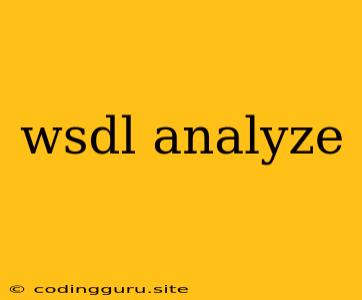Unraveling the Secrets of WSDL: A Comprehensive Guide to Analyzing Web Services Descriptions
In the realm of web services, communication relies heavily on a standardized language called WSDL (Web Services Description Language). This XML-based language defines the structure and capabilities of a web service, enabling clients to interact with it seamlessly. But what if you want to delve deeper into a WSDL document and understand its intricacies? This guide will provide you with the necessary tools and insights to analyze WSDL effectively.
What is WSDL?
WSDL serves as a blueprint for web services, specifying details like:
- Service Name: The identifier of the service.
- Port Types: The operations offered by the service.
- Messages: Data exchanged between the client and the service.
- Bindings: Protocols used for communication (e.g., SOAP, REST).
- Endpoints: URLs where the service is accessible.
Think of WSDL as a contract between the service provider and the client, ensuring both parties understand the rules of engagement.
Why Analyze WSDL?
Analyzing WSDL is crucial for several reasons:
- Understanding Service Functionality: You can gain a clear picture of the operations and data structures the service offers.
- Integration and Compatibility: Analyzing WSDL helps determine whether a service is compatible with your existing systems and integration tools.
- Debugging and Troubleshooting: Identifying potential issues with the service definition can save time and effort during development.
- Security Assessment: WSDL can provide insights into the security mechanisms employed by the service.
Methods for Analyzing WSDL
Several tools and techniques can be employed for WSDL analysis:
- XML Editors: Using dedicated XML editors allows you to examine the raw WSDL code and understand its structure.
- Online WSDL Analyzers: Numerous online tools provide intuitive interfaces for analyzing WSDL, generating visual representations and providing detailed information about the service.
- WSDL-Specific Libraries: Libraries in programming languages like Java and Python offer functionalities to parse and manipulate WSDL documents.
- Schema Validation: Validating the WSDL document against the XML Schema Definition (XSD) ensures its conformity to the standard and avoids errors during parsing.
Example Analysis
Let's consider a sample WSDL document:
Analyzing this WSDL:
- Service Name: "WeatherService"
- Port Type: "WeatherService" offers a single operation "GetWeather".
- Messages: "GetWeatherRequest" and "GetWeatherResponse" define the input and output data structures.
- Binding: The service uses SOAP over HTTP protocol.
- Endpoint: The service is accessible at "http://www.example.com/weather".
Best Practices for Analyzing WSDL
- Use a WSDL editor or analyzer: These tools provide a structured view of the WSDL document and highlight important elements.
- Validate against the XSD: Ensure the WSDL document adheres to the standard and prevents parsing errors.
- Document your findings: Record the analysis results, including the service capabilities, data structures, and any potential issues.
- Collaborate with the service provider: If needed, reach out to the service provider for clarification or further information.
Conclusion
Analyzing WSDL is an essential skill for developers working with web services. By understanding the structure and contents of a WSDL document, you can gain valuable insights into the service's functionality, ensure compatibility, and troubleshoot potential issues. This comprehensive guide has provided you with the knowledge and tools to analyze WSDL effectively.
